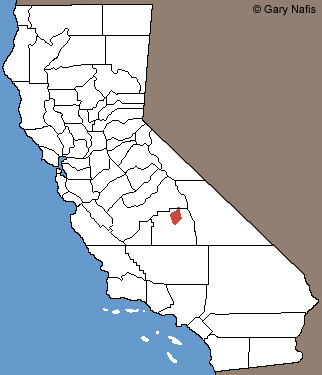
Red: Range in California
|
 |
| Adult, Tulare County |
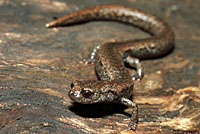 |
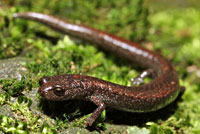 |
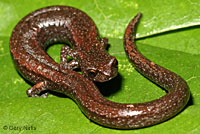 |
| Adult, Tulare County |
Adult, Tulare County |
Adult, Tulare County |
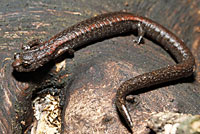 |
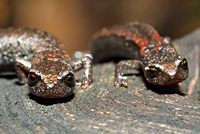 |
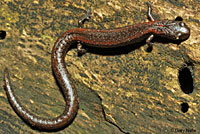 |
| Adult, Tulare County |
Adults, Tulare County |
Adult, Tulare County |
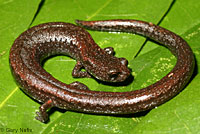 |
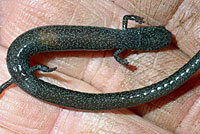 |
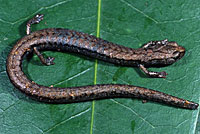 |
| Adult, Tulare County |
Underside of adult, Tulare County |
Adult, Tulare County |
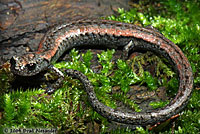 |
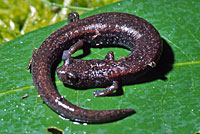 |
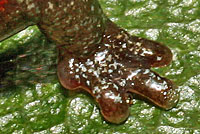 |
Adult, Tulare County
© Brad Alexander
|
Adult, Tulare County |
Slender Salamanders (genus Batrachoseps) have only 4 toes on their hind feet. All other California salamanders have 5 toes on their hind feet. |
| |
|
|
| Comparisons with some similar sympatric Slender Salamanders. |
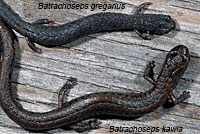 |
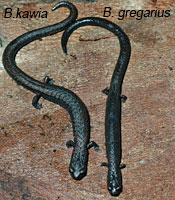 |
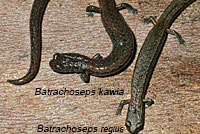 |
Top: B. gregarius - Gregarious Slender Salamander
Bottom: B. kawia
Note the larger, more robust body and limbs on B. kawia
|
Left: B. kawia
Right: B. gregarius - Gregarious Slender Salamander
Note the larger, more robust body and limbs on B. kawia
|
Left: B. kawia
Right: B. regius - Kings River Slender Salamander
There are no noticeable size differences in body, head, feet, or toes. |
| |
|
|
| Habitat |
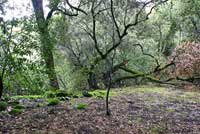 |
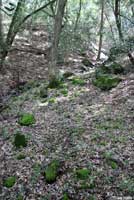 |
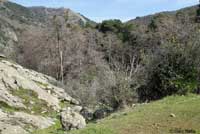 |
| Habitat, 3,400 ft., Tulare County |
Habitat, 3,400 ft., Tulare County |
Habitat, Tulare County
|
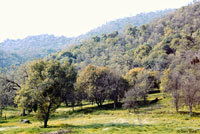 |
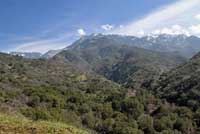 |
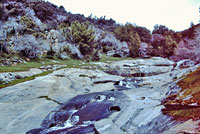 |
| Habitat, 3,000 ft., Tulare County |
Habitat, Tulare County |
Habitat, Tulare County |
| |
|
|
| Short Video |
| |
 |
|
| |
A look at several Sequoia Slender Salamanders in Tulare County. |
|
|
|
|
| Description |
| |
| Size |
Adults are 1 1/4 - 1 7/8 inches long (3.2 - 4.7 cm) from snout to vent.
|
| Appearance |
A small slim salamander, with 18-20 costal grooves.
Short limbs, a narrow head, long slender body, very long tail, and conspicuous costal and caudal grooves give this species the worm-like appearance typical of most Slender Salamanders.
There are four toes on the front and hind feet, which is also typical of Slender Salamanders.
(Other California salamanders have five toes on the hind feet.)
|
| Color and Pattern |
Dark brown or black above with a brownish or rusty dorsal stripe which is usually absent or not apparent.
Whitish speckling is extensive, especially on the sides.
Venter is gray and lighter than the sides.
|
| Comparison With Sympatric Slender Salamanders |
Occurs in sympatry with B. gregarius.
Sympatry with B. relictus is possible.
|
| Life History and Behavior |
A member of family Plethodontidae, the Plethodontid or Lungless Salamanders.
Plethodontid salamanders do not breathe through lungs. They conduct respiration through their skin and the tissues lining their mouth. This requires them to live in damp environments on land and to move about on the ground only during times of high humidity. (Plethodontid salamanders native to California do not inhabit streams or bodies of water but they are capable of surviving for a short time if they fall into water.)
Plethodontid salamanders are also distinguished by their nasolabial grooves, which are vertical slits between the nostrils and upper lip that are lined with glands associated with chemoreception.
All Plethodontid Salamanders native to California lay eggs in moist places on land.
The young develop in the egg and hatch directly into a tiny terrestrial salamander with the same body form as an adult.
(They do not hatch in the water and begin their lives as tiny swimming larvae breathing through gills like some other types of salamanders.)
|
| Activity |
Most Batrachoseps are active on rainy or wet nights when temperatures are moderate, fall through spring, retreating underground when the soil dries or when air temperature drops to near freezing.
At low elevation locations, this species has been found under surface cover from November to April.
At higher elevations, with more severe winter freezes, activity may be restricted to late spring through early fall.
Found under rocks, logs, bark, and other debris. |
| Defense |
Slender salamanders use several defense tactics, including:
- Coiling and remaining still, relying on cryptic coloring to avoid detection.
- Uncoiling quickly and springing away repeatedly bouncing over the ground, then remaining still again to avoid detection.
- Detaching the tail, which wriggles on the ground to distract a predator from the salamander long enough for it to escape.
(After its tail is detached or severed, the salamander will grow a new tail.) |
| Diet and Feeding |
Probably eats a variety of invertebrates.
Feeding behavior is not known, but other Batrachoseps species are sit-and-wait predators that use a projectile tongue to catch prey. |
| Reproduction |
Reproduction is terrestrial.
Little is known about the breeding behavior of this species.
Other slender salamanders reach sexual maturity at about 2 years of age.
Courtship probably occurs underground, but when it occurs is not known.
|
| Eggs |
| Other Batrachoseps species lay eggs in moist places on land. |
| Young |
Young develop completely in the egg and hatch fully formed.
|
| Habitat |
Inhabits diverse habitats, including mixed deciduous woodlands, mossy talus, and mixed coniferous forest.
|
| Geographical Range |
Endemic to the western slopes of the Sierra Nevada Mountains in California.
Found only in the Kaweah river drainage in Tulare county.
Known from only a few localities, the distribution of this species is probably more extensive.
|
| Elevational Range |
From
1,410 - 7,200 ft. (430 - 2,200 m.)
|
| Notes on Taxonomy |
Prior to its description in 1998, B. kawia was identified as B. relictus.
B. relictus was partitioned into four species -
B. diabolicus, B. regius, B. kawia and B. relictus.
Here's a Diagram of the Batrachoseps Complex showing the relationships between species.
Alternate and Previous Names (Synonyms)
Batrachoseps kawia - Sequoia Slender Salamander (Jockusch, Wake, Yanev 1998, 2003, 2012)
Batrachoseps pacificus - Pacific Slender Salamander (Stebbins 1985)
Batrachoseps attenuatus - California Slender Salamander (Stebbins 1954, 1966)
Batrachoseps attenuatus attenuatus - Worm-salamander (Bishop 1943)
Batrachoseps attenuatus - Slender Salamander (Storer 1925)
Batrachoseps nigriventris (Cope 1869)
Batrachoseps attenuatus (Cooper 1868)
Batrachoseps attenuata (Baird 1850)
Salamandrina attenuata (Eschscholtz 1833)
|
| Conservation Issues (Conservation Status) |
| Listed as imperiled by NatureServe, the reason why is not clear. There appears to have been little change in historical and current population numbers at the few known localities, most of which are on public lands. |
|
| Taxonomy |
| Family |
Plethodontidae |
Lungless Salamanders |
Gray, 1850 |
| Genus |
Batrachoseps |
Slender Salamanders |
Bonaparte, 1841 |
Species
|
kawia |
Sequoia Slender Salamander |
Jockusch, Wake & Yanev 1998 |
| Original Description |
Jockusch, E. L., D. B. Wake, and K. P. Yanev. "New species of slender salamanders, Batrachoseps
(Amphibia: Plethodontidae), from the Sierra Nevada of California." Contributions in Science, Natural History
Museum of Los Angeles County, #472 1998.
|
| Meaning of the Scientific Name |
Batrachoseps - Greek - batrachos = amphibian, frog + seps = lizard — describes lizard-like appearance
kawia - derived from the name of the Native Americans who inhabited the region of the type locality.
from Scientific and Common Names of the Reptiles and Amphibians of North America - Explained © Ellin Beltz
|
| Similar Neighboring Salamanders |
B. gregarius
B. regius
B. relictus
|
| More Information and References |
California Department of Fish and Wildlife
AmphibiaWeb
Hansen, Robert W. and Shedd, Jackson D. California Amphibians and Reptiles. (Princeton Field Guides.) Princeton University Press, 2025.
Stebbins, Robert C., and McGinnis, Samuel M. Field Guide to Amphibians and Reptiles of California: Revised Edition (California Natural History Guides) University of California Press, 2012.
Stebbins, Robert C. California Amphibians and Reptiles. The University of California Press, 1972.
Flaxington, William C. Amphibians and Reptiles of California: Field Observations, Distribution, and Natural History. Fieldnotes Press, Anaheim, California, 2021.
Nicholson, K. E. (ed.). 2025. Scientific and Standard English Names of Amphibians and Reptiles of North America North of Mexico, with Comments Regarding Confidence in Our Understanding. Ninth Edition. Society for the Study of Amphibians and Reptiles. [SSAR] 87pp.
Samuel M. McGinnis and Robert C. Stebbins. Peterson Field Guide to Western Reptiles & Amphibians. 4th Edition. Houghton Mifflin Harcourt Publishing Company, 2018.
Stebbins, Robert C. A Field Guide to Western Reptiles and Amphibians. 3rd Edition. Houghton Mifflin Company, 2003.
Behler, John L., and F. Wayne King. The Audubon Society Field Guide to North American Reptiles and Amphibians. Alfred A. Knopf, 1992.
Robert Powell, Roger Conant, and Joseph T. Collins. Peterson Field Guide to Reptiles and Amphibians of Eastern and Central North America. Fourth Edition. Houghton Mifflin Harcourt, 2016.
Powell, Robert., Joseph T. Collins, and Errol D. Hooper Jr. A Key to Amphibians and Reptiles of the Continental United States and Canada. The University Press of Kansas, 1998.
American Museum of Natural History - Amphibian Species of the World 6.2
Bartlett, R. D. & Patricia P. Bartlett. Guide and Reference to the Amphibians of Western North America (North of Mexico) and Hawaii. University Press of Florida, 2009.
Bishop, Sherman C. Handbook of Salamanders. Cornell University Press, 1943.
Lannoo, Michael (Editor). Amphibian Declines: The Conservation Status of United States Species. University of California Press, June 2005.
Petranka, James W. Salamanders of the United States and Canada. Smithsonian Institution, 1998.
|
|
|
The following conservation status listings for this animal are taken from the July 2025 State of California Special Animals List and the July 2025 Federally Listed Endangered and Threatened Animals of California list (unless indicated otherwise below.) Both lists are produced by multiple agencies every year, and sometimes more than once per year, so the conservation status listing information found below might not be from the most recent lists, but they don't change a great deal from year to year.. To make sure you are seeing the most recent listings, go to this California Department of Fish and Wildlife web page where you can search for and download both lists:
https://www.wildlife.ca.gov/Data/CNDDB/Plants-and-Animals.
A detailed explanation of the meaning of the status listing symbols can be found at the beginning of the two lists. For quick reference, I have included them on my Special Status Information page.
If no status is listed here, the animal is not included on either list. This most likely indicates that there are no serious conservation concerns for the animal. To find out more about an animal's status you can also go to the NatureServe and IUCN websites to check their rankings.
Check the current California Department of Fish and Wildlife sport fishing regulations to find out if this animal can be legally pursued and handled or collected with possession of a current fishing license. You can also look at the summary of the sport fishing regulations as they apply only to reptiles and amphibians that has been made for this website.
|
| Organization |
Status Listing |
Notes |
| NatureServe Global Ranking |
G2 |
Imperiled |
| NatureServe State Ranking |
S2 |
Imperiled
|
| U.S. Endangered Species Act (ESA) |
None |
|
| California Endangered Species Act (CESA) |
None |
|
| California Department of Fish and Wildlife |
None |
|
| Bureau of Land Management |
None |
|
| USDA Forest Service |
None |
|
| IUCN |
DD |
Data Deficient |
|
|
|

























